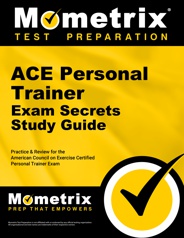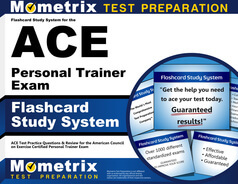The American Council on Exercise (ACE) administers the Personal Trainer Certification exam to assess the knowledge and skills of prospective personal trainers.
Click “Start Test” above to take a free ACE Personal Trainer practice test, and check out our premium-quality ACE Personal Trainer test prep resources by clicking the links below!
Exam Eligibility
To be eligible for the exam, you must be at least 18 years old, hold a high school diploma (or some equivalent), and hold a current CPR/AED certificate.
ACE Personal Trainer Exam Outline
The ACE Personal Trainer exam contains 150 multiple-choice questions, 25 of which are unscored, and you will be given a time limit of 3 hours. The unscored questions are scattered throughout the exam and are used to evaluate their validity for use on future versions of the exam.
The questions are split into four domains. Each domain contains multiple tasks, and each task contains a set of knowledge-based and skills-based areas.
I. Client Onboarding and Assessments (23%)
TASK A:
Obtain health, medical, exercise, and lifestyle information through questionnaires, interviews, and other appropriate documents to determine readiness and risk for exercise participation, identify the need for medical clearance and referrals, and facilitate program design.
Knowledge
- Effective communication strategies
- Tools and methods for gathering information for program design and implementation
- Dietary preferences and potential impacts on exercise
- Effects of common medications on physiological responses to exercise
- Impact of culture, ability, and age on rapport-building
- Appropriate dietary evaluation methods and their benefits, risks, and purposes
- Population-specific and condition-specific health and exercise considerations and contraindications
- Risk factors for cardiovascular and other chronic diseases or conditions
Skills
- Building rapport, developing trust, and establishing credibility with diverse populations
- Identifying the need for and obtaining medical clearance when appropriate
- Conducting effective interviews and gathering relevant health information prior to exercise participation
- Interpreting questionnaire responses to determine considerations for exercise participation
TASK B:
Assess client readiness for health-related behavior change and evaluate exercise attitudes and beliefs through effective communication to build rapport and establish appropriate goals.
Knowledge
- Common barriers and motivators for exercise participation and behavior change
- Types of goals and goal-setting processes
- Effective communication strategies
- Tools and methods for determining client preferences, readiness for behavior change, and attitudes
- Theories of behavior change
Skills
- Applying effective motivational interviewing strategies
- Building rapport, developing trust, and establishing credibility
- Collaborating with clients to set goals effectively
- Determining client preferences, readiness for behavior change, and attitudes
- Determining appropriate strategies to motivate program adoption and adherence
TASK C:
Identify and evaluate the quality of foundational movements through observations and assessments to develop appropriate exercise programming that enhances functional movement, health, fitness, and performance.
Knowledge
- Physical laws of motion
- Effective methods for assessing joint position, mobility, and stability
- Exercise-related kinesiology and anatomy
- Foundational movement patterns
- Biomechanics and joint mobility/stability
Skills
- Interpreting results of postural observation and movement screens to facilitate program design
- Selecting and administering appropriate methods for assessing movement, balance, and joint mobility/stability
- Identifying the effect of daily activities on movement and efficiency
- Observing and identifying exaggerated postural deviations
TASK D:
Select and conduct baseline fitness assessments based on client interviews, questionnaires, and standardized protocols to facilitate safe and effective program design and monitor changes over time.
Knowledge
- Appropriate application and sequencing of fitness assessments
- Effective communication strategies
- Exercise testing protocols, methods, and use of appropriate technology in different environments
- Variables that affect acute physiological responses to exercise
- Physiological responses to acute exercise participation and variations in workload
Skills
- Evaluating and interpreting fitness assessment results to facilitate program design
- Selecting and modifying appropriate fitness assessments based on individual needs and the environment
- Leveraging appropriate and available technology
- Identifying acute physiological responses
- Communicating fitness assessment results
II. Program Design and Implementation (31%)
TASK A:
Establish appropriate functional, health, fitness, and/or performance goals by interpreting client interview and assessment data to design personalized exercise programs.
Knowledge
- Nutrition and weight-management principles and guidelines
- Social determinants of health
- Exercise-related anatomy, biomechanics, and physiology
- Guidelines for interpreting client risk factors, health history, and readiness to exercise
- Personal factors influencing exercise participation and adherence
- Effective goal-setting strategies used to elicit behavior change
Skills
- Interpreting responses to assessments and exercise
- Communicating assessment results effectively
- Incorporating findings from various assessments
- Integrating responses to interviews and assessments into program design
- Designing individualized exercise programs based on interviews, assessments, goals, and lifestyle
- Facilitating effective goal-setting
TASK B:
Design personalized exercise programs by applying appropriate exercise principles and guidelines to enhance function, health, fitness, and performance.
Knowledge
- Components of fitness
- Appropriate methods for monitoring individualized responses to cardiorespiratory exercise
- Professional organizations that establish and publish standards and guidelines for exercise
- Exercise-related anatomy, biomechanics, and physiology
- General exercise and program-design principles
- Components of skill-related fitness
- Acute and chronic physiological and psychological adaptations to exercise
- Industry guidelines for exercise program variables
Skills
- Selecting and sequencing appropriate exercises based on individualized function, fitness, performance, and health
- Modifying instruction and program components to accommodate health and/or fitness status
- Designing individualized exercise programs in accordance with goals
- Implementing appropriate program components
- Modifying exercise techniques to promote safe participation and goal attainment
- Designing appropriate cardiorespiratory programs
TASK C:
Select appropriate exercises and equipment and integrate them into client programs in accordance with evidence-based research and guidelines to improve function, health, fitness, performance, and overall well-being.
Knowledge
- Appropriate exercise and equipment selection needed to achieve task and goal outcomes
- Physical laws of motion
- General exercise and program design principles
- Progressing or regressing the intensity/complexity of movement
- Acute and chronic physiological and psychological adaptations to exercise
- Monitoring individualized responses to cardiorespiratory exercise
- Optimal movement patterns and joint stability and mobility
Skills
- Identifying movement-pattern deviations
- Modifying program components to accommodate health/fitness status
- Implementing safe and effective exercise programs to address muscle imbalances
- Identifying physiological and psychological responses based on observation and feedback
- Incorporating appropriate exercises and equipment into program design
- Designing appropriate cardiorespiratory programs based on individualized exercise responses
- Identifying physiological and psychological demands of activities of daily living and lifestyle
TASK D:
Instruct clients on safe and effective exercise techniques and equipment use through verbal, visual, and kinesthetic cues to promote adherence and achieve program goals.
Knowledge
- Communication strategies
- Forms of cueing
- Appropriate breathing techniques
- Educational strategies used in promoting client safety and program success
- Appropriate exercise techniques using various modalities in different environments
- Measuring and monitoring exercise intensity
Skills
- Utilizing communication strategies that align with individual client needs and preferences
- Leveraging available technology in program implementation
- Recognizing and correcting compensatory movement patterns
- Modifying exercise techniques as needed to promote goal attainment
- Teaching safe and effective exercise techniques
III. Program Modification and Progression (27%)
TASK A:
Facilitate program adherence by providing clients with positive experiences that build self-efficacy using motivation, education, and program modifications to achieve client-centered goals.
Knowledge
- Risks and benefits of common diets and supplements
- Current fitness products, services, and methods
- Communication styles and techniques that promote adherence to goals
- Behavior-change models and human development theories/tools
- Factors that enhance safety, inclusivity, and belonging
- Acute and chronic physiological and psychological adaptations to exercise
- Factors that impact adherence to behavior-change programs
- Progressing or regressing the intensity/complexity of exercise movements
- Credible sources that support healthy lifestyle modifications
Skills
- Maintaining rapport, trust, and credibility
- Educating clients on managing factors that impact program adherence
- Educating clients on basic nutrition and weight-management guidelines
- Educating clients on managing the frequency, complexity, and intensity of exercises
- Modifying exercise technique, intensity, and selection as needed
- Motivating clients to adhere to exercise programs
- Educating clients on the risks and benefits of common diets and supplements
- Helping clients build self-efficacy, autonomy, and confidence
- Helping clients acquire knowledge of their own body
TASK B:
Recognize and respond to lapses in program adherence by acknowledging barriers and enhancers and collaboratively identifying solutions to facilitate consistent client engagement.
Knowledge
- Personal characteristics that influence communication, preferences, and lifestyle
- Factors that influence program participation and adherence
- Strategies to mitigate lapses and overcome common barriers to exercise program adherence
Skills
- Implementing strategies to help clients overcome barriers
- Identifying the need for referral to appropriate allied health professionals
- Adjusting program variables to promote adherence
- Appropriate verbal and nonverbal communication techniques
- Identifying potential barriers and enhancers that influence program adherence and goal attainment
TASK C:
Routinely evaluate program effectiveness through observations, client feedback, and data to collaboratively modify programs as needed.
Knowledge
- Nutrition assessments and protocols
- Industry guidelines for progressions and regressions
- Appropriate exercises and intensities
- Appropriate fitness assessments
- Primary movement patterns
- Appropriate modifications to program components based on observations, feedback, and data
- Physiological and psychological responses to exercise
- Criteria for terminating exercise
- Breathing techniques to execute various types of exercise
- Major muscle groups, joint actions, range of motion, and planes of motion
Skills
- Recognizing signs and symptoms of overtraining<//li>
- Eliciting client readiness to exercise through communication
- Gathering and interpreting client data and feedback to evaluate progress
- Selecting and administering appropriate assessments
- Modifying exercises, program variables, and techniques based on observations and feedback
- Recognizing signs for termination of exercise
- Identifying client readiness to exercise through observation
IV. Program Modification and Progression (27%)
TASK A:
Apply risk-management strategies in a variety of settings in accordance with recognized standards, guidelines, laws, and regulations to minimize liability and protect the client, personal trainer, and other relevant parties.
Knowledge
- Applicable guidelines, regulations, laws, and standards
- Factors contributing to negligence
- Methods for maintaining confidentiality and privacy through secure data storage and communication channels
- Basic procedures for emergency response within the scope of practice
- Risk-management protocols
- Industry guidelines for delivering exercise programs in various environmental conditions
- Best practices for delivering exercise programs
- Best practices for injury prevention and safety
Skills
- Referring clients to appropriate allied health professionals
- Selecting appropriate risk-management approaches
- Instructing and supervising safe and effective exercises
- Identifying and reporting potential hazards
- Modifying exercise sessions based on extreme environmental conditions
- Using safe spotting techniques
- Identifying, responding to, and documenting emergency situations and safety hazards
- Identifying and implementing proper protocols for safe and secure use of technology
TASK B:
Stay current with evolving health and fitness industry standards and job-related scope of practice to enhance professional credibility and trust.
Knowledge
- Professional conduct regarding communication platforms, proper use of technology, and protection of privacy
- Credible continuing education provides, resources, and programs
- Scope of practice, professional conduct, and the ACE code of ethics
- Equity, diversity, cultural competency, and inclusion
Skills
- Identifying appropriate relationships and identifying professional boundaries with colleagues and clients
- Disseminating relevant exercise programming and educational information based on individual needs
- Discerning credible from noncredible resources
- Demonstrating appropriate actions that promote equity, inclusion, diversity, and cultural competency
- Selecting appropriate communication channels based on personal trainer and client agreements
TASK C:
Pursue ongoing knowledge of evolving ethical business practices in a variety of health and fitness settings to enhance the client experience.
Knowledge
- Emerging trends that influence personal training
- Behavior-change models and theories pertaining to client behavior and decision-making
- Components of the allied healthcare continuum
- Legal documents and procedures
- Components of a business plan
- Basic principles of a marketing plan
Skills
- Building a referral network
- Cultivating appropriate client recruitment and engagement opportunities
- Gathering, interpreting, and implementing client feedback appropriately
- Applying concepts and practices to support diversity, inclusion, equity, and justice
- Using emerging equipment and programming platforms to enhance the client experience
- Integrating appropriate technological platforms to serve client needs
- Identifying appropriate opportunities to advance personal knowledge
Check Out Mometrix's ACE Personal Trainer Study Guide
Get practice questions, video tutorials, and detailed study lessons
Get Your Study Guide
Exam Registration
You can register for the exam by visiting the ACE website. You will need to provide any applicable eligibility documentation, as well as the $499 examination fee.
You should receive confirmation of your registration and preferred examination method (in person or remote) within minutes of submitting your registration.
Test Day
In-person Testing
On test day, you should arrive to the testing center about 15 to 30 minutes prior to the official start time.
After you arrive, you must provide your ID, and your picture will be taken for security purposes. You will then be asked to store all personal items in a secure locker, including your cell phone, hats, wallet, food, and keys.
Once your personal items are secured, you will enter the testing room and work through the identification screen and a tutorial at your testing station. Once this step is complete, your exam will begin.
Live Remote Proctoring (LRP)
The day before your exam, check the compatibility of your computer’s audio, video, and webcam components. If your computer runs any system update between when you schedule your exam and when you launch your exam, you may experience issues with compatibility. Best practice is to ensure any system update is postponed from the time you schedule to the time you complete your exam.
On the day of your exam, ensure that your testing area is clear of reference materials, your cell phone, and food or drink containers. You are permitted two pieces of blank paper and a writing utensil for writing notes. You must use the Google Chrome browser and enable cookies. Ensure you can move the webcam around for the proctor so they can view your area. Present your ID and scratch paper for inspection and follow any directions provided.
You can launch the examination up to 30 minutes before your scheduled appointment. You cannot leave the webcam’s view during your exam, use other monitors, or talk to anyone. If the proctor observes questionable behavior, your exam will be canceled.
How the Exam is Scored
Your ACE Personal Trainer exam score is determined using a scaled scoring method. This method takes your raw score (how many questions you answered correctly) and converts it to a numerical score between 200 and 800. You will need a scaled score of at least 500 to pass the exam.
You should receive your score results immediately upon completing the exam.
Retaking the Exam
If you do not pass the exam, you may retake it after a one-year waiting period. You must pay a discounted examination fee for your first retake. Any subsequent retakes require the full examination fee.
Check Out Mometrix's ACE Personal Trainer Flashcards
Get complex subjects broken down into easily understandable concepts
Get Your Flashcards
FAQs
Q
How many questions are on the ACE Personal Trainer exam?
A
There are 150 multiple-choice questions on the exam.
Q
How long is the ACE Personal Trainer exam?
A
The time limit for the exam is 3 hours.
Q
What is the passing score for the ACE Personal Trainer exam?
A
To pass the exam, you must achieve a minimum scaled score of 500.
Q
How much does the ACE Personal Trainer exam cost?
A
The examination fee is $499.
